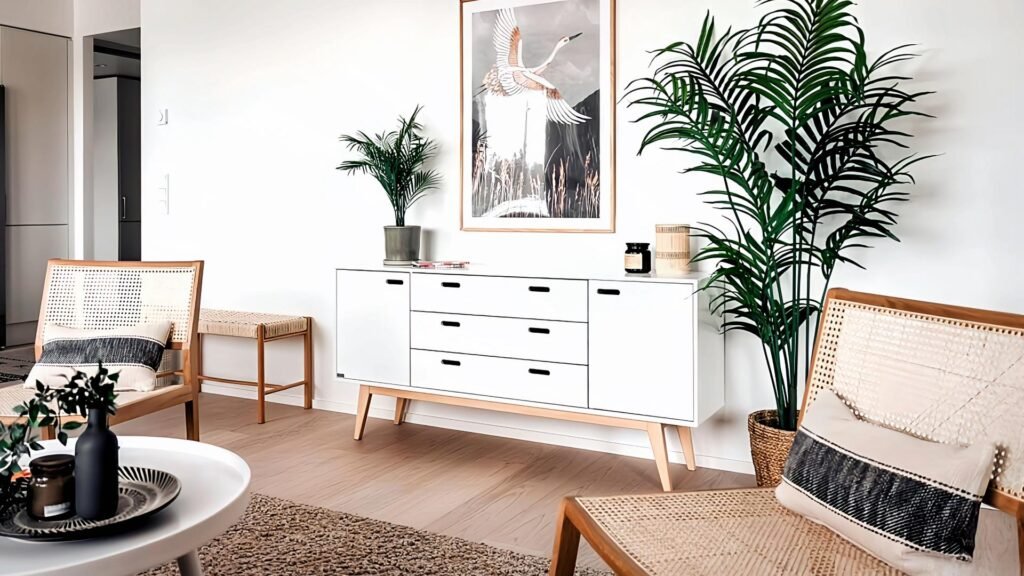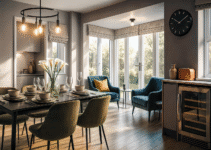Explore the art of creating calming and serene interiors with our comprehensive guide. Learn how to use white, neutral tones, and natural wood elements to craft a peaceful atmosphere in your home. Discover practical tips and expert advice for transforming your living spaces into tranquil sanctuaries that promote relaxation and well-being.
Introduction to Calming Interiors
Creating a serene and calming living environment is essential for personal well-being, and thoughtful interior design plays a pivotal role in achieving this. Welcome to the second part of our comprehensive guide, where we delve deeper into crafting tranquil spaces using white, neutrals, and natural wood elements. This video series aims to provide a cohesive and harmonious approach to home decor, emphasizing the calming effects of these design choices.

White and neutral tones establish a serene foundation that promotes peace and relaxation, making them ideal for creating a tranquil atmosphere at home. These color palettes act as a blank canvas, allowing you to introduce subtle accents and personalize your space without overwhelming the senses. Additionally, natural wood brings warmth and texture, adding a touch of organic beauty that complements the minimalist appeal of a calm interior.
Please read our article watch the newly uploaded video from our YouTube channel:
“Grig Stamate – Interior Design Solutions”
https://www.youtube.com/@GrigStamate
50 CALMING Interior Decor Solutions – White, Neutrals, and Natural Wood, #2 (video)
Here, you can see other related videos from our channel:
MODERN MINIMALIST Living Rooms that Prove the Beauty of Less (video)
50 CALMING Interior Decor Solutions – White, Neutrals, and Natural Wood (video)
In contemporary interior design, there’s a growing appreciation for simplicity and clarity, often manifested through the effective use of white, neutrals, and wood elements. This trio not only enhances the aesthetic appeal of a space but also fosters an environment conducive to relaxation and mindfulness. By reducing visual clutter and incorporating elements rooted in nature, we can craft a sanctuary that promotes mental clarity and emotional well-being.
As we continue this journey, we aim to provide you with practical tips, expert advice, and inspirational ideas to help you transform your living spaces into havens of tranquility. Whether you’re embarking on a full-scale renovation or looking to make subtle tweaks, our guide is dedicated to assisting you in creating a home that exudes calmness, serenity, and balance.
Recap of Part 1
In the first part of our series on calming interior decor solutions, we explored the fundamental principles of creating a serene and tranquil environment in your home. We emphasized the importance of harmony in design, focusing on the use of white, neutrals, and natural wood to foster a calming atmosphere.
To set the stage, initial tips included integrating soft, neutral color palettes, which can significantly impact the overall mood of a space. White and beige tones, when used effectively, create a sense of openness and serenity, offering a perfect backdrop for relaxation. Additionally, we discussed the significance of natural light and its ability to enhance the calming effects of neutral hues. Ensuring that your spaces are well-lit with natural light during the day can contribute drastically to a peaceful ambiance.
Adding to the foundational design principles, Part 1 also covered practical solutions such as decluttering and the use of minimalistic furniture. Decluttering not only helps in maintaining a clean and organized space but also reduces mental stress by providing a sense of control and peace. Minimalistic furniture with clean lines and natural textures was highlighted for its ability to contribute to a calm and uncluttered look.
The use of natural materials, particularly wood, was another focal point. Incorporating natural wood elements can imbue your interiors with warmth and a sense of connection to nature, which is inherently calming. We provided suggestions on integrating wooden furniture, flooring, and accents to enhance the natural aesthetics of your home.
Lastly, we touched on the importance of incorporating elements of nature, such as indoor plants, which not only purify the air but also add a touch of greenery, promoting relaxation and well-being.
This recap sets the stage for the new ideas and advanced tips presented in Part 2, where we will delve deeper into creating a sanctuary at home using calming interior decor solutions.
Benefits of Using White in Interior Design
Implementing white in interior design offers a multitude of psychological and aesthetic benefits that can transform living spaces into serene havens. One of the primary advantages of using white is its ability to evoke a sense of cleanliness and purity. Spaces dominated by white tones often appear uncluttered and organized, fostering an environment conducive to relaxation and mindfulness. This perception of cleanliness is particularly effective in areas such as kitchens and bathrooms, where hygiene is paramount.
White also has the intrinsic quality of enhancing light and space. By reflecting natural and artificial light more effectively than darker shades, white can make rooms feel larger and more open. This illusion of expanded space is especially beneficial in smaller rooms or urban apartments where maximizing square footage is essential. For example, a small bedroom painted entirely in white can feel more spacious and inviting, while a white living room can promote a sense of airiness and freedom.
Moreover, white interiors can create a calming atmosphere, pivotal for mental well-being. The neutrality of white helps to reduce visual clutter, allowing for a tranquil setting where individuals can unwind and recharge. This calming effect extends across different rooms, from living areas to home offices, providing a peaceful backdrop for various activities.
However, incorporating white in interior design requires a nuanced approach. An overuse of white can lead to spaces feeling sterile and devoid of character. It’s essential to balance white with different textures and materials to introduce warmth and depth. For instance, pairing white walls with natural wood furniture not only breaks the monotony but also adds an organic touch that enhances the overall aesthetic.
Incorporating white in design involves careful consideration and strategic application to harness its full potential. When used wisely, white can elevate an interior space, making it feel cleaner, more open, and infinitely more calming.
Exploring Neutral Tones
Neutral tones, encompassing shades like beige, taupe, and gray, form the cornerstone of calming interior decor. These hues, known for their versatility, can be combined in myriad ways to create sophisticated and tranquil environments. Integrating a harmonious palette of neutrals requires an understanding of their subtleties and the ability to balance them effectively within various spaces.
Beige, often associated with warmth and comfort, works exceptionally well in living rooms and bedrooms. This shade offers a serene base upon which other colors can be layered. Conversely, taupe, with its blend of brown and gray, adds depth and richness, making it suitable for common areas where a touch of sophistication is desired. Gray, heralded for its modern and sleek appeal, fits seamlessly into contemporary designs, promoting a sense of calm through its understated elegance.
When selecting neutral shades, consider the natural light within the space. Rooms bathed in natural light benefit from cooler shades of gray, which can prevent the area from feeling overly bright or stark. On the other hand, spaces with limited natural light flourish with warmer tones of beige and taupe, which enhance the light available and create a cozy atmosphere.
To avoid a monotonous look, balance is key. Introduce varying textures and materials to add interest and dimension. For instance, pairing a plush beige sofa with taupe linen curtains and a gray wool rug can create a dynamic yet cohesive look. Accents in natural wood and metal finishes further enhance the ensemble, contributing both contrast and warmth.
Effective use of neutral colors also involves layering different shades within the same color family. For example, mixing light and dark grays or combining warm and cool beiges keeps the decor visually engaging. Well-placed accessories, such as throw pillows, artwork, or vases in complementing neutral tones, amplify the sophistication while maintaining the serene ambiance.
In any room, the ultimate goal is to create a balanced and inviting space. Skillfully selecting and combining neutral tones can transform interiors into peaceful retreats, blending elegance with a soothing, understated charm.
Bringing in Natural Wood Elements
The integration of natural wood into interior design plays a pivotal role in creating a warm and inviting atmosphere. Natural wood, with its unique grain patterns and textures, adds depth and character to any space, making it an essential component for a calming and homely environment.
Different types of wood offer their own distinctive qualities, each lending suitability for various applications throughout the home. Oak, known for its strength and pronounced grain patterns, is ideal for furniture and flooring, bringing a sturdy yet elegant feel to living areas and bedrooms. Pine, with its lighter hue and softer texture, is a popular choice for accent pieces and cabinetry, offering a rustic, airy quality that promotes tranquility. Walnut, characterized by its rich, dark tones, is perfect for statement pieces like coffee tables and headboards, infusing a touch of sophistication and warmth.
Utilizing natural wood in different parts of the home can significantly enhance the ambiance. In the living room, a solid wood coffee table or bookshelf not only serves functional purposes but also creates a focal point that exudes comfort and refinement. For the kitchen, natural wood countertops and cabinets can transform the space into a welcoming heart of the home. Bedrooms benefit from the serene qualities of wood through bed frames and nightstands, fostering a restful retreat. Even bathrooms can enjoy the calming influence of wood with vanities and shelving units, balancing modern fixtures with organic elements.
Moreover, the calming effect of natural materials cannot be overstated. Wood’s natural warmth and texture contribute to a peaceful atmosphere by reducing the starkness often associated with synthetic materials. The presence of natural wood elements helps to soften interior spaces, making them more approachable and soothing. This connection to nature is inherent to promoting well-being, creating a sanctuary where one can relax and unwind.
Layering Textures for Depth and Calm
Layering textures is an essential technique in interior design to enhance the calming atmosphere of a space. Incorporating a variety of materials such as linen, wool, and rattan can add visual interest and depth, creating a soothing sanctuary that is both inviting and serene. When done correctly, these textures blend seamlessly with white, neutral tones, and natural wood, resulting in a balanced and harmonious environment.
Linen, with its cool, crisp feel, is an ideal choice for curtains, upholstery, and bedding. Its natural fibers provide a light, airy texture that complements the neutrality of white and wood. Consider using linen drapes in a soft off-white tone paired with a wooden rod for a sophisticated yet relaxed look. Linen slipcovers for sofas or armchairs add a layer of texture while maintaining an understated elegance.
Wool, on the other hand, brings a warm, cozy element to any interior space. A woolen area rug in a neutral shade such as taupe or ivory can ground a room with its plush, inviting surface. Throw blankets and pillows made from wool or wool blends can be strategically placed on furniture to introduce a tactile dimension without overwhelming the senses. Wool’s earthy texture aligns perfectly with the tranquil aesthetics of natural wood elements.
Rattan, renowned for its natural, woven look, injects an organic feel to the decor. Incorporate rattan through furniture pieces like chairs, side tables, or even light fixtures to add a touch of natural beauty. Rattan baskets can serve as both functional storage and decorative accessories, blending effortlessly with a neutral palette and wooden accents.
Combining these textures thoughtfully ensures that each element contributes to the overall sense of calm. For instance, a living room featuring a linen-covered sofa with wool throw pillows, a rattan coffee table, and natural wood accents will exude a harmonious, tranquil vibe. This multilayered approach not only adds depth but also engages the senses, creating an environment that is both visually appealing and soothing.
Accessorizing with Minimalism
When accessorizing a minimalist interior, the key is to strike a harmonious balance between functionality and aesthetics. Begin by selecting a few standout pieces that contribute to the overall calming ambiance created by the white, neutral tones, and natural wood accents. Opting for accessories that are both beautiful and practical ensures they serve a purpose beyond mere decoration.
To maintain the minimalist principle of ‘less is more,’ focus on quality over quantity. Instead of cluttering surfaces with numerous small items, choose larger, more impactful pieces. For instance, a single, elegant vase made of natural materials like glass or ceramic can serve as a focal point on a coffee table or sideboard. Similarly, a strategically placed piece of abstract art can add visual interest without overwhelming the space.
Natural elements provide a serene and calming touch to minimalist decor. Incorporating houseplants introduces a breath of fresh air and complements the organic feel of natural wood. Select plants with simple, clean lines, such as succulents or a graceful fiddle leaf fig, which can enhance the tranquility of the space without demanding too much attention.
Functional accessories, such as stylish storage baskets or boxes, help to keep clutter at bay while adding texture and depth. These pieces should align with the room’s color palette—think woven baskets in neutral shades or sleek wooden trays. Their utilitarian nature ensures they contribute to the functionality of the space while adhering to the minimalist aesthetic.
Textiles also play a crucial role in minimalist decor. Select fabrics that offer subtle texture and understated elegance. Soft throws, cushions, and area rugs in neutral tones can add warmth and comfort without distracting from the overall serenity. Look for high-quality, natural fibers like cotton, wool, or linen, which enhance the tactile experience and harmonize with the natural wood elements.
In essence, the goal is to create a space that feels open, airy, and uncluttered. By carefully curating accessories with an eye for simplicity and natural beauty, you can achieve a minimalist interior that exudes calm and serenity.
Final Tips and Encouragement
As you embark on the journey to create a calming interior space, remember that the process is highly personal and adaptable to your individual preferences. Here are some actionable tips to guide you through implementing soothing decor solutions using white, neutrals, and natural wood.
Firstly, begin with a neutral base. Shades of white and soft neutrals provide a serene backdrop, making your space feel larger, cleaner, and more peaceful. Integrate natural elements, such as wooden furniture or decor items, to add warmth and texture to the room. These elements bring a touch of the outdoors inside, further enhancing the tranquil atmosphere.
Mix and match textures to add depth to your decor. Incorporating different materials like cotton, linen, and wool can lend a cozy feel without overwhelming the senses. A balance of textures in neutral tones aids in creating a tactile experience that is both comforting and visually appealing.
Consider the importance of decluttering. A clutter-free space contributes significantly to a sense of calm and order. Allocate spaces for personal belongings and thoughtfully choose decorative pieces that add to the overall peaceful ambiance. Remember, minimalism in decor doesn’t mean bare; it means intentionality in your choices.
Focus on natural lighting whenever possible. Large windows or strategically placed mirrors can amplify the available light and enhance the airy feel of the room. Complement this with soft, ambient lighting to maintain a soothing environment during evening hours.
Finally, be flexible and true to yourself. Your home should reflect your personality and provide comfort. There are no rigid rules in creating a calm space; what matters most is how the space makes you feel. Experiment with different elements, and don’t be afraid to make adjustments until the space feels right for you.
Creating a calming interior is a rewarding journey aimed at making your home a sanctuary where you can unwind and rejuvenate. Trust your instincts and let your personal tastes guide you in crafting a space that brings peace and tranquility to your everyday life.
Other related posts from our website:
Let’s see here, three of them:
https://howtobuildahouseblog.com/40-new-apartment-design-ideas-elegance-in-simplicity-part-13/
We also sincerely hope you like our ideas from this post, and you have also enjoyed our uploaded YouTube video.
See you next time at another article.
Thank you so much for your time. Bye now!



No Responses